LGBT History Month: Gay Rights in Belfast and Beyond by Emma Reisz, Nadine Gilmore and Tom Hulme
Just two years ago, in 2017, the Police Service of Northern Ireland marched in the city’s LGBT Pride Parade for the first time. Many have welcomed the move, but others were bitterly critical – some still bearing the scars of past discrimination at the hands of the law. Recent progress draws attention to the ups and downs that LGBT people have faced.
For LGBT History Month in February 2019, a display of books in the library outside Special Collections commemorates this complex history, and the long shadow history casts over the present.
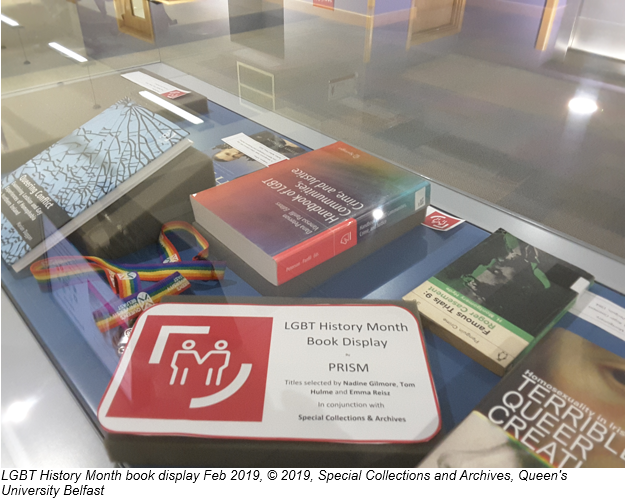
Homosexuality was for a long time a punishable offence in Britain – all the way back to medieval sodomy laws – though these were often only selectively applied, and sodomy could be hard to prove in court. In Ireland, sodomy was regularly prosecuted only from the seventeenth century.
Gaelic poetry in the medieval and early modern periods could include intense homoeroticism, such as Brian Ó Gnímh’s 1586 elegy to the spiked head of Alasdair Mac Donnell: “I love the still-unbleached red mouth/Head of silk complexion . . ./ . . . smooth delicate cheek/ . . . fine soft abundant curling tresses/ . . . gaze-holding green eyes”.
Sex between women was never specifically criminalised, but until recent times, it was difficult for most women to live outside male control.
A few who resisted the restrictions on women lived as men. Occasionally “female husbands” married women, and were vulnerable to prosecution for fraud if exposed. Social, financial, educational and sexual motives can be difficult to untangle, often making it hard to say whether a particular individual can be understood in today’s categories as lesbian, trans, or neither.
Margaret Ann Bulkley from Cork became a student at Edinburgh Medical School in 1809 under the name James Barry. Barry qualified in 1812, over fifty years before Elizabeth Garrett Anderson became the first acknowledged woman doctor. Barry went on to a prominent career in the British Army, and only in death in 1865 did Barry’s birth sex become public knowledge.
Albert Cashier (born Jennie Hodges in 1843) emigrated from Co. Louth to America, and enlisted in the Union Army during the American Civil War (alongside hundreds of other females serving as men). Cashier’s birth sex was unknown to all except a few close friends, and Cashier’s funeral in 1915 included full military honours.
Persecution of male homosexuals in Britain and Ireland intensified in the nineteenth century. The Labouchere Amendment in 1885 made any sort of sexual activity between men illegal, making convictions much easier to obtain. The most famous Irish figure to fall foul of this persecution was Oscar Wilde in the late 1890s in London. Henry Labouchere may even have had Wilde in mind when he wrote his amendment; the two men met in 1882, and Labouchere dismissed Wilde as an “effeminate phrase maker”.
Belfast also had its own stories. Edward de Cobain, an Irish Conservative MP for East Belfast in the 1880s, faced the full force of public scandal when he was charged with gross indecency.
Even more notorious was Roger Casement, a former British Foreign Office diplomat turned Irish Nationalist revolutionary. He was arrested for treason in the lead up to the Easter Rising in 1916, and his reputation besmirched when the British government privately circulated scandalous sexual extracts from his diaries – many of which concerned the young men he had met in Belfast. Casement was denied clemency and executed.

According to Casement’s diaries, in the years before the First World War men in Belfast “cruised” for sexual encounters around the Botanic Gardens and Ormeau Park. Among Casement’s many lovers was a Belfast Bank employee from Myrtlefield Park, Joseph Millar Gordon, who was identified by the authorities thanks to a £25 motorbike – a gift from Casement.
Many men from Belfast and Northern Ireland were tried and convicted before decriminalisation, from all social classes and both religious communities. Yet there has always been queer culture in Belfast, even if it was mostly hidden from view. Hotels, public toilets, parks, and pubs; all have been places where men could meet men despite the disapproval of broader society. Times of international conflict especially, both the First and Second World Wars, provided a background of social chaos that enabled meetings to flourish. Court reports from 1917, for example, describe cocktail parties in private rooms in the Imperial Hotel where soldiers rubbed shoulders with students and danced the night away.

The increased freedom enjoyed by women increased public awareness of lesbianism. The writer and campaigner Eva Gore-Booth from Sligo (sister of Constance Markievicz) shared a life partnership with Esther Roper from 1896 until Gore-Booth’s death in 1926. Gore-Booth co-founded Urania magazine in 1916, arguing for gender equality and praising female same-sex relationships as preferable to marriage for women. [1]
Concerned by the apparent increase in lesbianism, the House of Commons voted in 1921 to criminalise “gross indecency” between women, to match the law applied to men. But the House of Lords believed making lesbianism illegal would only glamorise it, and vetoed the change.
After the Second World War, a new period of repression and intolerance began in the UK. In the claustrophobic atmosphere of the Cold War, many homosexual men bore the brunt of an anxious society. By the late 1950s, convictions of prominent individuals like the actor John Gielgud were bringing increased public attention to the law on homosexuality. Government was also concerned the law could be used by the Soviet Union and others to blackmail homosexual British officials. A government committee was established under John Wolfenden to review the legal situation.
Wolfenden recommended legalising homosexual behaviour in private between two consenting adults over 21; not condoning homosexuality, but admitting it was neither a disease nor incompatible with normal mental health. ‘It is not,” Wolfenden argued, “the function of the law to intervene in the private life of citizens, or to seek to enforce any particular pattern of behaviour.”
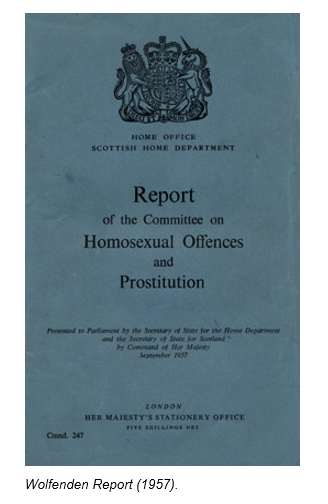
Perhaps the most vocal advocate in Parliament for homosexual law reform in the 1950s was Montgomery Hyde, a Queen’s graduate and the Ulster Unionist MP for Belfast North. Hyde was deselected as an MP by his constituency association in 1959 over his support for Wolfenden. He went on to write books on Wilde, Casement and homosexuality.
It took another ten years of arguments and debates before the recommendation was carried into law in England and Wales in 1967. Gay men in Scotland had to wait until 1980, and male homosexuality was not decriminalised in Northern Ireland until 1982.
In the quarter-century which passed between Wolfenden’s recommendations and their implementation in Northern Ireland, a generation of gay men grew up knowing their love was a criminal offence.
Local gay rights groups in Northern Ireland, such as the Gay Liberation Society, Union for Sexual Freedoms Ireland (USFI) and the Northern Ireland Gay Rights Association (NIGRA), campaigned vigorously in 1970s to bring Northern Irish law into line with England, petitioning local representatives and Westminster politicians.
Demands for law reform in Northern Ireland were defeated by outspoken opposition from religious conservatives, resistance from some of the public, and apathy from many politicians. The Reverend Ian Paisley instigated the infamous “Save Ulster from Sodomy” campaign in 1977, collecting 70,000 signatures for a petition opposing the extension of the 1967 Act to Northern Ireland.
It was not until the European Court of Human Rights ruled in favour of a local gay rights activist, Jeffrey Dudgeon, in a landmark court case in 1981 that the British Government was forced to decriminalise homosexual acts in Northern Ireland.
The Dudgeon v United Kingdom case was hugely significant, since it created a precedent that homosexuality could not be criminalised in any country which was a signatory to the European Convention on Human Rights. A few years later in 1988, David Norris won a similar case against the Republic of Ireland, finally leading to decriminalisation there only in 1993. Even courts outside Europe have been influenced by Dudgeon v UK. It was cited by the US Supreme Court in Lawrence v. Texas in 2003, the decision which legalised male homosexuality in every US state.
In both Northern Ireland and the rest of the UK during the 1970s, the gay liberation movement was developing, demanding direct action for equality, and pride in place of shame.
After decriminalisation in England and Wales, prosecutions there against gay men actually rose by 55% between 1966 and 1974, and many expressions of homosexuality remained illegal, such as advertising to meet someone for sex.[2] While the Campaign for Homosexual Law Reform demanded decriminalisation in Ireland both North and South, the Campaign for Homosexual Equality in England and Wales focused on an equal age of consent and protection from discrimination. The Gay Liberation Front staged radical protests and infiltrated groups who had oppressed the gay rights movement, interrupting their events with spontaneous flash mobs and setting loose hordes of mice upon unsuspecting conference delegates.

In Belfast, the Gay Liberation Society at Queen’s pursued equality alongside law reform from 1972, protesting publicly even while at risk of prosecution. The 1974 GLS pamphlet Gay Forum: Seven Essays on Homosexuality included essays with such uncompromising titles as “Woman-Identified-Woman” by Maeve Malley and “On Being A Fairy” by Richard Sinclair, as well as a description of Ireland’s first Symposium on Homosexuality at Trinity College earlier that year.
Also in 1974, Cara-Friend was established in Northern Ireland to offer emotional support, placing newspaper advertisements reading “Homosexuals, do you have questions?” alongside a telephone number. In Dublin, a similar service opened in the same year, named Tel-A-Friend by David Norris (now Gay Switchboard Ireland).
Visibility brought risks: the police rounded up a number of activists in 1976.
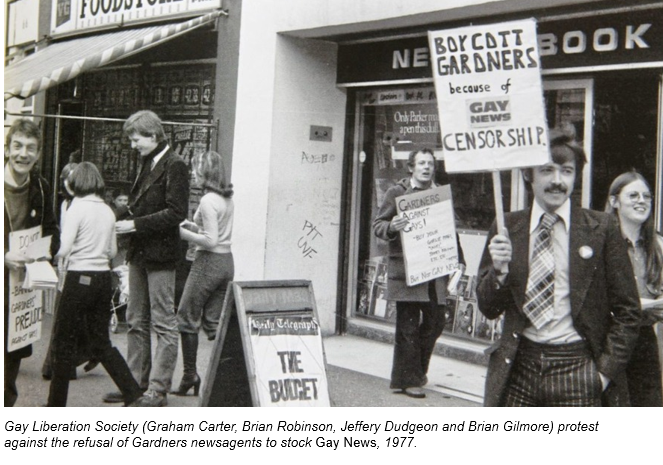
Police harassment and hostility was a particular issue in Ireland both north and south, before and after decriminalisation. The suspected homophobic murder of Anthony McCleave in 1979 was closed by police within twenty-four hours of McCleave’s death. Though campaigners worked relentlessly to get the case re-opened and to keep it in the public eye, no-one was ever charged.
Gay newspapers like NIGRA’s Gay Star, as well as Update (later upstart) campaigned against the “Portsmouth Defence” (gay panic defence) where defendants pleaded not guilty of violent crime because they alleged they had been reacting to a sexual advance. When Declan Finn was murdered in 1982 in Dublin, a suspect told Gardaí “we were all part of the team to get rid of queers in Fairview Park”. The group was convicted of manslaughter, but they walked free after the judge stated “this could never be regarded as murder” and handed down suspended sentences. Protests against Finn’s murder galvanised the Irish gay rights movement into substantial protests.
Despite both criminalisation and the Troubles, there were places for gay people in Belfast to meet and socialise. From the 1950s, the clientele of the bar at the Royal Avenue Hotel included gay men and a few lesbians, and from 1974 the Royal Avenue ran gay discos in the hotel ballroom. The Royal Avenue eventually closed during the Troubles. The Casanova Restaurant also attracted a gay crowd, but was bombed on 5 October 1976.
Many gay venues were frequented by both Protestants and Catholics, and at the height of the Troubles, this inclusive atmosphere attracted some heterosexuals too, such as the mixed crowd at the popular Gay Liberation Society club night at McMordie Hall. [3] As the lesbian history collection Threads puts it, “The big metal security barriers which created the ‘Ring of Steel’ did not deter us. We took the chance to go through it. We did not agree or comply with the limitations set by a divided society.”[4]
In the 1980s, gay rights in the UK increasingly focused on the devastating HIV and AIDS crisis. New gay activist groups became the frontline in fighting the spread of the virus, giving care, support and advice to people whom governments were either unable or unwilling to reach. British organisations like Terrence Higgins Trust (1982) and ACT UP (1987) had little impact in Northern Ireland, so the Rainbow Project was established in 1994 in Belfast. The Dublin Aids Alliance was founded in 1987 with similar aims.
Gay men were blamed for the spread of the epidemic, especially within the tabloid press. They faced a new wave of homophobia and discrimination, often dismissed from work and treated with suspicion by hospital staff who were reluctant to touch them.
The backlash against the gay community culminated in 1988 in Section 28 of the Local Government Act, making it illegal for local authorities to “intentionally promote homosexuality” or “promote the teaching in any maintained school of the acceptability of homosexuality as a pretended family relationship”. This was the first piece of legislation which actively discriminated against both lesbians and gay men and resulted in a strong coalition between gay and lesbian activists who condemned the law and the implications it would have for LGBT people, particularly in relation to the issue of sex education.
Even in the 1990s, Belfast could be a difficult place to be openly LGBT. At the first Belfast Pride in 1991, there were only 100 marchers, countered by numerous protestors opposed to gay rights.
The Good Friday Agreement in 1998 began a process which led to significant improvements in the legal rights of LGBT people in Northern Ireland. The Northern Irish Human Rights Commission was established the following year, with a responsibility to promote and protect human rights. In its first year, the Commission initiated a review of “the law, policy and practice… affecting the rights of persons who are gay, lesbian, bisexual or transgendered [sic]”.[5]
After an NIHRC report in 2002, it became illegal to discriminate on the grounds of sexual orientation in Northern Ireland in employment (2003) and goods and services (2007).
The beginning of the twenty first century also brought the first steps toward equality for transgender people in Northern Ireland and the rest of the UK. Discrimination on the grounds of “gender reassignment” was banned in 1999, and the Gender Recognition Act of 2004 brought about legal recognition of transgender identities.
Despite continued hostility in some quarters, LGBT community and arts organisations came into the mainstream in Belfast in the early twenty-first century. QueerSpace was established in 1998, and the Outburst Queer Arts Festival was established in 2006.
Wider social change has come only slowly. In a 2007 study, Northern Ireland was found to be the most homophobic Western country.[6] In 2008, a prominent Northern Irish politician and wife of the First Minister, Iris Robinson, told an interviewer that gay people were an “abomination” and made her feel “sick”. Marriage equality was introduced in England, Wales and Scotland in 2014, but has been blocked by politicians in Northern Ireland.
Opposition to anti-discrimination measures has focused around the Christian Institute, which in 2007 led a coalition of Christian groups challenging the ban on anti-gay discrimination. Since then, the Christian Institute has supported a number of legal cases relating to discrimination law, including the Ashers “gay cake” case, in which the Supreme Court held in 2018 that a bakery did have the right to refuse to make a cake supporting gay marriage.
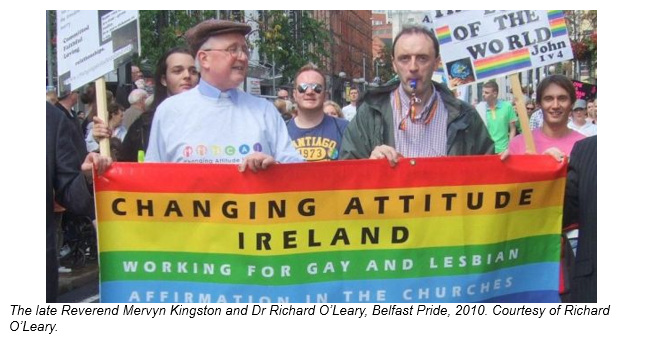
For some Christians in Northern Ireland, the challenge was instead to find a place for LGBT people within their churches, paralleling other Gay Christian movements around the world. Changing Attitude Ireland (CAI) campaigned was established in 2007 as an LGBT-straight campaign group for “full acceptance and welcome for lesbian, gay, bisexual and trans people in the Churches in Ireland”.
Significant obstacles continue to affect the lives of trans people. Trans* organisations in Northern Ireland like SAIL (2012) and AffirmNI (2014) provided support and worked towards social inclusion, healthcare and full equality, while the Belfast Trans Resource Centre opened in 2016. Stacey Gregg’s play Scorch, about a “gender-curious teen” and issues of identity and disclosure, premiered at Outburst in Belfast in 2017 and won the Irish Times Theatre Award for Best New Play.
Despite continued inequality, trans people became more visible in public life. Victoria McCloud, the most senior openly trans judge in the UK, was the youngest Master in the High Court of England and Wales at the time of her appointment in 2006. At the 2nd Annual Pride Law Lecture at Queen’s in 2018, Master McCloud noted that “the stigma associated with the intersection of transgender status and medical diagnosis contributes to precarious legal status, human rights violations, and barriers to appropriate health care”. Yet, she told her audience, “If we bring the colours of the Rainbow into the law library and the legal profession and the judicial Bench, the greys and blacks of the law take on the brightest and most hopeful shades.”
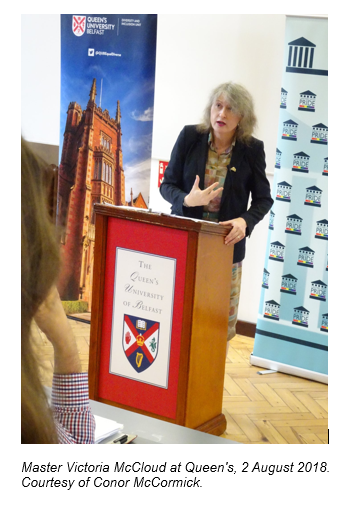
While LGBT people do not yet have full legal and social equality in Northern Ireland, Belfast Pride now attracts tens of thousands of participants and onlookers, and only a handful of protesters.
The community has come a long way in Northern Ireland – even if it has taken slightly longer than the rest of the UK and the Republic of Ireland as well. LGBT History Month is a good time to remember that the fight for equality is not over, and that we still need to be vigilant to protect those rights we do have.
The LGBT History Month book display will be exhibited outside Special Collections in February 2019.
1. Sonja Tiernan, Eva Gore-Booth: An Image of Such Politics (Manchester, 2012), p. 224
2. H. Cocks, ‘Conspiracy to corrupt public morals and the ‘unlawful’ status of homosexuality in Britain after 1967’, Social History, xli, no. 3 (2016), p. 279.
3. See Jeff Dudgeon, ‘Mapping 100 Years Of Belfast Gay Life’, The Vacuum, no. 11.
4. “Jayne” [Moya Morris], Threads : Stories of Lesbian Life in Northern Ireland in the 1970’s and 1980’s, 2008.
5. The First Annual Report of the Northern Ireland Human Rights Commission (1999), p. 22.
6. Vani K. Borooah and John Mangan, ‘Love Thy Neighbour: How Much Bigotry Is There In Western Countries?’, Kyklos, 60.3 (2007), 295–317.


Thanks ♥️
There were 117 on Belshaft’s first Pride – I was on the 1st Pride in London in 1972 – there were less than a thousand on it. When you consider that its ‘catchment area’ was all of GB population @ 50 million it makes Belfast’s showing quite substantial. NI’s population was @ 1.5 million.
Hello, my names susan, i was one of the brave people in 1991 the first gay pride march.
What truely bothers me is that it seems to be Almost written out of history, and also very glibbly and cheerfully derided by gay folk of recent times, who have not a clue what it was really like.
I was young and at the time like most young people, i just thought “aye sur itl be a laugh” so me and a few mates, stephen graham brian white, eamon and wan, the other eamon from dublin who was keen cyclist and a funny guy i remember his cheeky wink and humour, the two traceys one was a girl i went to the limelight with for a while, rodney from lisburn went he was a nice fella with big red cheeks and big eyes, i remember you, stormin norman, queen fan from bang whore (bangor) lol as he put it , he went and the three we guys from grovener andrew mark and the other we mans name escapes me they went, agh long time ago, along with jeff dudgeon, P a mcglouglan and yer man with big bushy beard and glasses he lived same house with P A at the time he went too, i liked him he was a real funny laugh and real knowledgable,
Conor hughs went too he was a gegg, others went whom i cant mind, like me some were young trans people oh i think neil rolston went as liz taylor lol that day i liked neil he didnt like me back then but we eventually got on nice terms.
Weve all been written out a history now nobody gives a poo, i do though, and i remember well, i had pete burns type hair extensions all crimped lol that day, there were activitys planned it was great gas that day.
I remember the first exchange weekend we did in May 1993 down in Galway, P A, hired an old blue ford transit van loloolll, we were on our way and as we approached the markets area of belfast the van flippin well broke down, it was a gegg oh how we laughed we had to get out qnd push lol, we john clements went with us that time he was nice he gave me a james and susan wells 12 inch single which i still have, denver rosborough went too, as did stephanie graham, and briege from the shac building, she went with her other half we met a fella called richard from galway red hair big glasses real slim he looked after all us in his house,
Richard came lived in belfast for a few yrs he got seriously depressed and went back, oh and a nice french fella called arno went with us a lovely funny guy he was, his freind katrine was french too, she drove a white vw beetle and was a great gal,
oh how i miss those days in man ways, it was all no where near as sensationally bad as people try to make out at all, we paid no mind and just lived and got on with it all, i find it much harder now than in 1990s, i remember delaneys bridge st and bob ran it those weekends delaneys was the best and music was a good mix there, i really liked it those three yrs, the police tried hassling us one night but it just turned into a gegg with liz taylor climbin into the meat wagon and kickin his heels up then the police then just realsed that night folk were human like them they craked funny jokes and all ended fine, there was larry’s piano bar too with the old holywood regalia
tokyo joes near ogees, a laugh boogie or two had there, the venue i never liked, the parliament thompsons garage the lime light which was great the only club then that used the spinning clay paki lights at the 80 s section of the night greqt stuff, the dreaded crows nest, i stopped going there in 93 but it was a laugh sometimes, and then the kremlin opened end of decade, i didnt like that place, so i stopped the scene in late 99′ and never been out on it since
I wonder how much other people remember
Sean mcgouran its you!!! Lol who’s name escaped me (bimbo) and you commented before me too lol, oh my i really thought you were great man along with jeff and p a miss you all, i used to vist your house and it was filled with books and newspapers, serious men you were but always with a sense of humour,
I paragraphed my last comment it wont be posted now,, lol, cause the preview its all lumped together editor please paragraph it and post it lol,